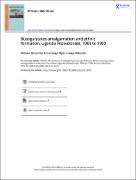| dc.contributor.author | Musamba, William | |
| dc.contributor.author | Rukooko, Byaruhanga Archangel | |
| dc.date.accessioned | 2023-06-02T08:21:38Z | |
| dc.date.available | 2023-06-02T08:21:38Z | |
| dc.date.issued | 2023-06-01 | |
| dc.identifier.other | DOI: 10.1080/14725843.2023.2215415 | |
| dc.identifier.uri | http://hdl.handle.net/20.500.12280/3021 | |
| dc.description.abstract | Contrary to the common perception of colonialism as an exercise of power within the context of ‘divide and rule’, this study fore-grounds Ali Mazrui’s concept of ‘unite and rule’ as another funda-mental aspect of British colonial policy in East Africa. Unable to implement indirect rule in the multifarious Busoga states, the British colonialists were compelled to adopt the policy of unprecedented amalgamations, thereby creating a single ethnic identity at the beginning of the twentieth century. Overtime, Busoga came to be perceived as a territory of the Basoga: one of the major ethnic groups in modern Uganda. The rise of the Abataka Associations as opposition groups to the politics of states amalgamation enhanced the Basoga ethnic identity. However, the transition from the pre- colonial independent states to a single Basoga ethnic identity is hardly historicised in previous scholarship. This qualitative study therefore uses primary sources of archival materials in the Uganda National Archives and Jinja District Archives and five key informant interviews to historicise the primacy of agency in the process of Busoga ethnic formation between 1900 and 1950. | en_US |
| dc.language.iso | en | en_US |
| dc.publisher | Routledge - Taylor & Francis Group | en_US |
| dc.relation.ispartofseries | African Identities; | |
| dc.subject | Busoga | en_US |
| dc.subject | Busoga amalgamation | en_US |
| dc.subject | Basoga | en_US |
| dc.subject | Basoga ethnic formation | en_US |
| dc.subject | Y.B.A | en_US |
| dc.subject | Abataka Association | en_US |
| dc.title | Busoga states amalgamation and ethnic formation, Uganda Protectorate, 1900 to 1950 | en_US |
| dc.type | Article | en_US |


